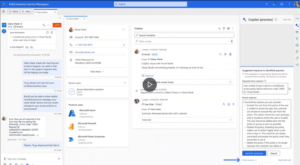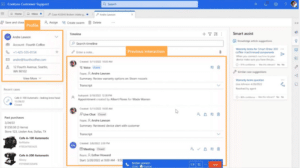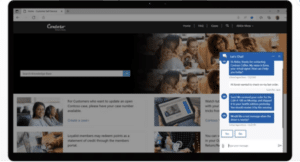The Contact Center Revolution: Driving Field Service Excellence Through Customer Engagement
Field Service excellence occurs when you support your agents, invest in self-service options, and enlist the right bots to pick up the slack.
Table of Content
Customer expectations have been rising for a long time.
This is old news, of course, dating all the way back to the dawn of the smartphone and the emergence of tech power players like Amazon, Uber, Google, and Facebook (or, uh, Meta).
Many industries – CPG, ecommerce, hospitality, among others – learned an important lesson a long time ago: either find a way to keep up with the tech giants (and their deep, deep pockets) or, you know, just give up and die.
In 2023, field service companies are now in that same position, albeit, a full decade later. That means, providers must reimagine how they engage customers, meet expectations, and empower them to connect on their own terms.
A lot of these improvements are driven by backend decisions. Think – investing in tools that better support technicians, digitizing, and eventually, automating basic tasks, and using intelligent insights to drive decision-making. But, there’s a lot you can do on the front end, too.
In these next few sections, we’ll look at some of the ways you can level up contact center ops by supporting your agents, investing in self-service options, and enlisting the right bots to pick up the slack.
In the field service space, it’s easy to forget that the “front lines” extend beyond the face-to-face interactions between field techs and customers.
While most field service orgs do generate most of their business value from, you guessed it, field-based services, the contact center does most of the heavy lifting when it comes to managing and orchestrating the overall service experience.
See, it’s the contact center that manages the constant deluge of service requests, cases, and communications pouring in from all channels. It’s on them to schedule calls, dispatch technicians, and track the status of every open work order.
Service agents are typically the first point of contact for customers. They’re the ones picking up the phone when there’s an emergency, fielding questions, and sending help when needed.
As you can imagine, contact center operations have a massive impact on field operations– and the customer relationships that sustain them.
Our point is, investing in field service management that makes life easier for critical support teams like customer service agents, dispatchers, field managers, etc. directly benefits your customers, your field techs, and your bottom line.
Unfortunately, there’s no definitive enablement stack you can throw your budget at and implement ASAP. What you’ll want to do here is look at the capabilities your current solutions already offer.
For example, both D365 Business Central and F&O have customer-centric capabilities baked into each module. They also integrate directly with the Microsoft Power Platform, Azure, and the whole suite of MS productivity tools — Excel, Teams, and the rest.
If you’re a Microsoft user, you’re likely already sitting on a bunch of capabilities that could be used to support your contact center staff. It’s just that you’ll need to weave them together to design workspaces and workflows that actually meet their needs.
Here’s an example of what that might look like:

So, D365 Field Service includes scheduling, technician tracking, and resource management tools that can be used alongside features from the Customer Service module – be it case management, intelligent routing, or real-time insights into where each account or job stands in the moment.
As you scan your stack, you’ll want to look for collaborative support tools that facilitate cross-functional collaboration. When support teams work in silos, it’s hard for them to get information or input from other departments.
The problem gets much worse when support agents are working remotely and can’t lean on their teammates for support. This, of course, is frustrating for customers (something all of us have no doubt experienced many times) and leads to worse outcomes.
D365 Customer Service now includes embedded Teams chat and case swarming capabilities, which help agents solve problems faster.
Users can also design intelligent workspaces that make it easier for agents to work on multiple cases at a time from a single app. The in-app AI can analyze customer sentiment, transcribe phone conversations, and surface relevant knowledge articles or solved cases that might help solve the problem faster.

The platform also allows users to automate basic tasks–like confirming appointments, inviting experts to “swarm,” routing work orders, and surfacing helpful resources so agents can get through calls faster.
That said, you might also need to invest in dedicated solutions that provide deeper customer insights, allow you to orchestrate journeys, automate workflows, or get some extra support from AI.
Effective contact center management allows customers to engage with your org on their terms – chat, email, SMS, social, or even good old-fashioned landlines.
According to Gartner, 74% of customer service leaders say creating seamless customer journeys across both assisted and self-service channels is either “important” or “very important.”
And, in a 2022 white paper, Microsoft says the first principle of modern customer service is showing up exactly when and where customers want you to be.
As always, rising to expectations that border on the impossible begins with a unified platform. Last year, Microsoft launched its Digital Contact Center Platform, which combines several MS solutions — D365, Teams, the Power Platform, and Nuance AI — into one flexible customer care platform.
Standalone solutions, including D365 Customer Service, Marketing, Sales, and the Business Central ERP do include features that support omnichannel engagement. And, those capabilities can be enhanced with the Power Platform, ISVs, or 3rd-party integrations.
But, the Contact Center provides a pre-made infrastructure for designing end-to-end contact center operations, making it easier to provide personalized service across all connected channels.
It also allows you to automate repeatable tasks, optimize individual journeys, and ensure that all interactions are secure.
Building on the last section, sometimes engaging on customers’ terms means taking a hands-off approach.
Principal Consultant Erica Ellis says, “many FSM tools make it easy for providers to offer more self-service options. This gives customers the ability to book appointments, update their own records electronically, and access support through their preferred channels.”
It’s important to understand that “self-service” can mean a lot of things, including:
For example, a customer might report their issue in the chat box, and the bot might then ask a series of yes-or-no questions to point them in the right direction.
Here’s what that might look like:

From there, it might share a few links from your knowledge base, help the customer book an appointment, or connect them to a human agent. If customer assets are IoT-enabled, chatbots can lead them through simple repairs or help them troubleshoot the problem.
For technicians and contact center employees, self-service channels are a valuable investigative tool. They capture details about the problem that can be analyzed against customer records, service histories, and similar issues your team has resolved in the past.
Service teams — whether in the field or the contact center — can use that information to start working on resolutions before making the trip. And, by drawing on institutional knowledge, they can also quickly start troubleshooting issues based on past successes.
But – again, whatever self-service solutions you end up investing in must be informed by actual customer needs and proven support agent pain points.
Like, it doesn’t make sense to hedge your bets on some Facebook-specific chatbot when few customers use that particular channel to communicate with business contacts, friends, or brands they’re thinking of working with.
It also doesn’t make sense to, say, shell out for the full Microsoft Contact Center experience without first asking your contact center staff, where, exactly, they might benefit from letting AI or self-service channels take the reins once in a while.
Contact center operations are at the heart of any successful field service practice, so it’s easy to make the connection between investing in FSM tools that make life easier on support agents, dispatchers, and even the customers themselves.
But, again, there are simply way too many options. Even if you focus solely on D365 apps, finding the right solution is incredibly overwhelming.
Velosio’s field service experts can help you navigate the selection process, implement your chosen stack, and optimize your platform for peak performance. Contact us today to learn more about our approach, proprietary solutions, and advisory services – all designed to help field orgs fuel long-term success.
How can Copilot affect your company’s workflow and goals? Contact us to learn the benefits of Copilot and how it can impact your company’s workflow for the better.